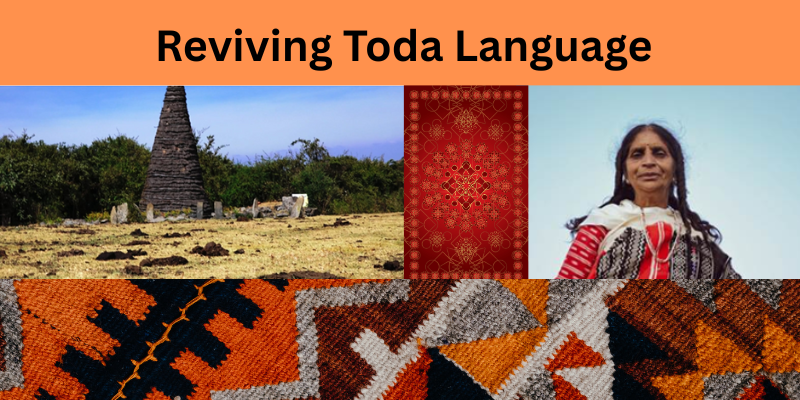
This article is available for free. Please log in or subscribe to access all articles.
“Our family god called Kuladheivam in Tamil, has a temple in our village called poɬliwoʃ,” said the 66-year-old Kurtaz Vasamalli, who lives in the Nilgiri hills near Ooty. “We believe that the divine power comes to our villages from the temple…there is no idol worship.”
The hills, which are renowned for tea and coffee plantations, are considered sacred by the Toda tribe, who have lived there for thousands of years. The pastoral community believes that their gods and goddesses lived among them once and became a part of the sacred landscape over time.
Vasamalli knows her oral traditions through her native language Toda. Toda is an endangered proto-South-Dravidian language which evolved in isolation after splitting from South Dravidian (like Kannada, Telugu and Malayalam). The Toda people number a few thousand now. Vasamalli is one of the elders of the community striving to preserve her traditional oral heritage.
Vasamalli most recently worked with the Scheme for Protection and Preservation of Endangered Languages (SPPEL) team being implemented by the Mysuru-based Central Institute of Indian Languages (CIIL) under the Ministry of Education. SPPEL works to document and archive the country's endangered languages—languages spoken by fewer than 10,000 speakers or languages not previously studied linguistically.
SPPEL aims to preserve and revitalize endangered languages for future generations by conducting field work and documenting the grammar and words of languages, creating documentaries, bi-lingula/tri-lingual dictionaries, pictorial glossaries and ethno-linguistic profiles, and uploading the documentation work, including audio files, to online repositories for worldwide access.
Currently, SPPEL has identified 117 endangered languages, and is working toward documenting about 500 lesser-known languages in the future.
Various other schemes by the Government of India work toward the preservation and promotion of tribal and vanishing cultures. India’s National Education Policy 2020 promotes multilingual studies to preserve local languages.
This local effort reflects a global concern. Endangered languages and cultures are a global phenomenon. Close to half of 7,000 languages globally are endangered globally, according to the United Nations Educational, Scientific and Cultural Organization. UNESCO has declared the period between 2022 and 2032 as the International Decade of Indigenous Languages to draw attention to the critical situation of many indigenous languages and to mobilize stakeholders and resources for their preservation, revitalization and promotion.
The International Day of the World's Indigenous Peoples on August 9 was established by the United Nations to draw attention to the rights of indigenous peoples living in 90 countries.
Vasamalli grew up knowing various stories in Toda, even as she learned Tamil in school and picked up English. She always wanted to learn more about her culture. “I happened to get a copy of a few books in the Toda language and found the phonetic letters.”
Kurtaz Vasamalli
Vasamalli has worked with various linguists who travelled to her community and were interested in learning about and preserving the Toda language. She most recently worked with the SPPEL team for the development of the Toda primer in Tamil script.
Vasamalli’s multilingual journey reflects a broader pattern across India. In India, out of a total population of 121.09 crore, about 89.59 crore are monolingual, 22.90 crore are bilingual, and 8.60 crore are trilingual, according to the 2011 Census.
However, multilingualism is heavily skewed toward dominant languages. The highest number of monolinguals speak Hindi (46.74 crore), followed by Bengali (7.98 crore) and Marathi (4.39 crore)—all major scheduled languages.
For endangered tribal languages like Toda, this presents a challenge: speakers must often choose between preserving their native tongue and accessing education and opportunities in dominant languages.
The Ministry of Tribal Affairs addresses this challenge through bilingual dictionaries and trilingual education modules, supporting the National Education Policy 2020's three-language formula to help tribal students maintain their heritage while gaining broader linguistic skills. SPPEL has documented the Toda language, which lacks a native script, and is about to publish a Toda primer—an introductory book for beginners—in the Tamil script for dissemination among children.
The importance of such written documentation is something Vasamalli understands. “The elders are not teaching us and others like they used to and there is a lot more to the language. It is better to have written records.” She sees that many Toda youth are interested in learning about their culture and history, giving her hope for the language's future. “We need to create situations that bring them back to their roots and back to the community, while also helping them engage with the outside world.”
We believe there is divine power. If we protect the land, trees, and nature, we will receive blessings from God. That is the basic principle of the Toda community,” Vasamalli said. She said that a mountain is called kot̠ajen and the Toda believe that their god by the same name lives there.
Toda’s linguistic heritage is being promoted through SPPEL’s extensive work, which involves the following documentation and promotion steps, which are as follows:
Recording phase: Capturing words, sentences, songs and stories.
Transcription and analysis: Converting recordings into the written form; examining the language's grammar, sound systems, and word-formation process; and building lexicons.
Grammar construction: Writing the grammar by explaining the rules of the language including that of sentence formation.
Cultural documentation: Recording livelihood practices, documenting rituals, capturing festivals and community traditions.
Digital archiving: Digitally preserving the records of the language by creating metadata for all recorded materials and uploading them to repositories for worldwide access, and long-term preservation.
SUBMIT REVIEW
Please email us: editor.rajagirimedia@gmail.com